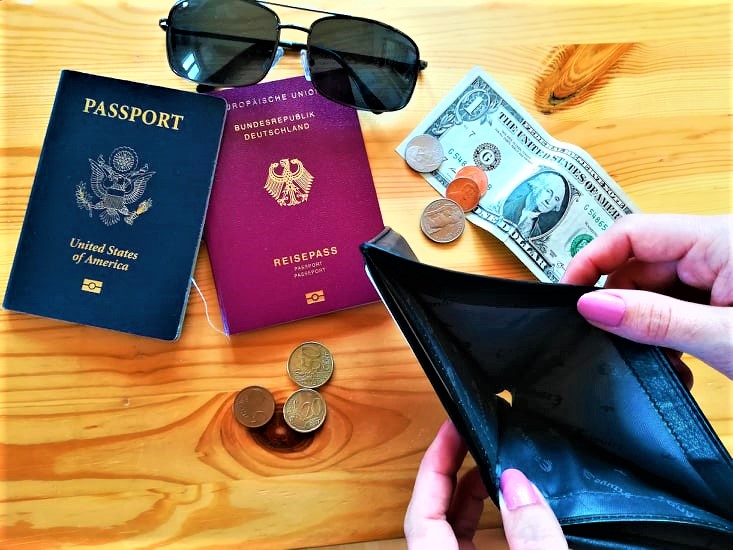Foreign ATM Tips in this Article
The Problem with Foreign ATMs
Anyone who’s traveled to a foreign country has most likely spent some time in front of an odd ATM that is asking strange questions or wording things in such a confusing manner that there’s no way of knowing if they’re about to sign away their soul or get the deal of a lifetime. There’s no escaping it. As a traveler, you are completely reliant on money and at some point, you will inevitably find yourself at a crossroad between just eating the ridiculous fee, accepting the terrible exchange rate or moving on cashless with the hopes that you’ll find a better ATM. These are indeed stressful situations, but they don’t have to be. We’ve traveled enough to where we’ve seen pretty much every ATM trick in the book and that’s why we’re here now to tell you what you should be looking out for and how you can save money at ATMs instead of losing it.
What does it mean when an ATM says…
ATMs can really trip up their customers by using unclear words and phrases. In some cases, this is purposefully done in an attempt to cause the user to choose an option that will force him or her to pay an additional fee or to accept an unfair exchange rate. In this section, we’ve listed out some common phrases that tourists run into while using foreign ATMs.
“Would you like to accept this exchange rate? The exchange rate might change by the time your bank processes the transaction. Select yes to guarantee this rate and avoid possibly paying more later.”
This is a scare tactic to trick you into accepting the ATM’s ridiculous exchange rate. When an ATM offers you an exchange rate, it is usually even worse than swapping out cash at a money changer. Your bank, on the other hand, will process the transaction at the exact exchange rate on the day the transaction comes through. The country in which your bank is located may affect the rate they honor, but any difference will likely be cents and not tens of dollars. Sometimes, your bank’s rate is even better than the current market rate. Bottom line is this: unless you’re in a very unstable country, the real exchange rate isn’t going to fluctuate drastically enough by the time your withdrawal comes out to cause you to spend more through your bank than through this ATM. Just say no.
“Debit in local currency and with conversion?”
We’ve often seen this one at international ATMs and those that will allow you to withdraw in multiple currencies. Much like the trick above, the ATM is trying to trick you into accepting an awful exchange rate. This one’s pretty clever because it’s really confusing. We first ran into this one while spending a day in London. We were trying to withdraw pounds (GBP), but our bank uses Euros (EUR). In this case we were given the following two options:
“DEBIT in GBP and WITH CONVERSION”
or
“DEBIT in EUR and WITHOUT CONVERSION”
This is actually really confusing, right? We wanted to withdraw pounds, so it seems logical to choose the first option. The problem is that we didn’t like the exchange rate at all, so we didn’t want the conversion. We selected CANCEL and were given the requested amount at the interbank exchange rate (the real rate). We accidentally did the right thing and we saved 82 pounds by refusing the ATM’s rate.
Here’s what you need to understand: The currency you’re debiting in is what your bank will see. By selecting option No. 1 in this case, you are accepting the ATM’s exchange rate AND your bank will see a withdrawal in the foreign currency, meaning they will add the real exchange rate to that and you lose twice. If you have a bank that charges for foreign withdrawals, then you lose thrice (three times—I couldn’t resist the opportunity to use the word “thrice”).
What’s with option No. 2? The general rule is to never debit in your own currency when using a foreign ATM, as that ATM will still use their own exchange rate. So what do you do? If you have no other way of getting cash, then you’ll be cornered into making a decision.
There must be an option to let your bank handle the exchange rate. This is what you want and in most countries, the ATM providers are legally obligated to give you this option. However, it isn’t always clear. Sometimes, the option is placed somewhat out of sight, it’s really small or it’s very poorly worded. In our case, the option was non-existent. The option was automatically given to us by selecting cancel.
In order to get the real exchange rate, these are your 2 requirements:
- Withdraw (debit) in local currency
- Decline ATM’s conversion (regardless of what they say)
This gives you the real exchange rate on that day and puts the right amount of local cash in your hand.
“Your bank may charge you a fee for this transaction”
This one is actually pretty straight forward, but can be confusing if you’re not expecting it. There are two keys to getting past this one. First of all, it’s important to know your bank’s policies on foreign transactions. Secondly, “may” does not mean “will.” The ATM doesn’t know your bank’s policies, so the service provider is protecting itself in case you are charged a fee that you weren’t expecting. When you see this statement and there is no other information about ATM fees, then 90% of the time, you can expect a fee-free withdrawal (unless your bank charges you something).
“This ATM charges a transaction fee of $X.XX in addition to any charges incurred by your bank”
Obviously, an ATM that charges a transaction fee isn’t going to be anyone’s first choice. In some cases, however, it’s unavoidable. If you see a message like this one, you may be wondering what those additional charges could be. Just as we mentioned in the point above, it’s important to know your bank’s policies. If your bank does not charge you for foreign withdrawals, then you should expect to only pay the ATM fee.
If you find yourself in a situation where you can’t avoid paying an ATM fee, then we find it’s best to estimate how much cash you’ll need for the entire time you’re going to be in the country and withdraw it all at once. That is the most economic way. If you find you’re not comfortable having that much cash on hand, then you should try to withdraw in amounts that will minimize your number of visits to the ATM.
Extra tip: If you do find yourself with a wad of cash, then it’s also best to separate that cash and store it in different (safe) locations. Do not keep all of it in your wallet or purse. If you’re not traveling alone, then you can split up the cash amongst your group members. The reason for this is simple. If you lose your wallet or purse, or something gets stolen, then you reduce the likelihood that all of your cash has been lost with it.
Extra extra tip: Avoid getting pickpocketed by using a Pacsafe to carry your valuables with you. We always have two of these on hand and have never had a single problem yet.
Poorly Translated ATMs
Another thing to be weary about is poorly translated information displayed on the ATMs. We were recently in Vietnam and used an ATM that said our bank may charge us fees. It was clear to us when using the ATM that the translators were not the best. The wording didn’t make much sense, but we understood it to mean that there would be no ATM fee. We were wrong. Even though no fee was ever displayed to us, the ATM did in fact charge us $2 for the withdrawal. The takeaway is this: If the ATM is not easy to understand, then move on to another one that is easier to understand. You don’t want to take the chance that you’ll get hit with a hidden fee or a bad exchange rate.
The Most Reliable ATMs
If you can, always go inside a bank to withdraw money. This gives you the most security and peace of mind. However, these still aren’t always the best options in terms of fees. An ATM inside a bank will generally be straight forward and honest about fees, but you can sometimes get better ATM fees by using free-standing ATMs from smaller banks. For example, when we were in Tulum, Mexico, we found the best ATM was operated by a local bank and located in a supermarket. The fee was much lower than those from the big name banks and they had an armed guard keeping watch. In short, just look around and find the option that works best for you. You can also see which ATM the locals tend to go for in order to give you a better idea.
Money Orders
If you find yourself in a country or situation where an ATM just isn’t an option, then you may be considering sending yourself a money order. Unfortunately, our favorite money transfer service, Azimo, has been bought out and is no longer processing money orders. That money order service essentially saved our lives while we were in Argentina (read about money problems in Argentina, here). With this service, we were able to get our first two transfers fee-free and with a better than usual exchange rate. In fact, we actually earned money on the first transaction.
Be sure to look into all of your options, but at the time, that was the only money order service we had ever been truly happy with.
What’s your experience with ATMs?
Have you been tricked by an ATM or been forced to pay hidden fees. Tell us your ATM horror stories in the comments. Likewise, let us know if we missed anything or if you have any tips we haven’t thought of yet!





I used to be so on guard with foreign ATMs after adding up how much I spent just getting my money out on trips, but then I changed banks to one that refunds all of those fees. It makes me so happy to see that money go straight back into my account (including one time when it was $9 for one transaction). It’s definitely worth shopping around for a bank that has your back with them!
That’s very true! We have better conditions now too, but we’re still always on the lookout for hidden fees because you never know!